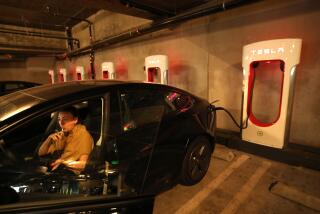Hughes’ Device Eases Charging of Electric Cars : Innovation: A small, plastic paddle slides into a slot in the vehicle, giving a full-day recharge in about an hour.
- Share via
Hughes Aircraft Co. on Monday announced its concept for a line of recharging devices for electric cars that could someday be as standard to motorists as the traditional gasoline pump.
The Hughes system is designed to be easier to use than current charging systems for electric cars that employ a plug and socket. The Hughes device requires inserting a five-inch plastic-covered paddle, resembling a compact audio disc with a handle, into a slot in the automobile.
“If electric vehicles are to be successful in the marketplace, it is essential that drivers have convenient access to charging stations,” Hughes Executive Vice President James A. Abrahamson said.
U.S. and foreign auto manufacturers are gearing up to meet California clean-air standards, which are also likely to be adopted elsewhere in the United States. By 1998, 2% of a car maker’s annual production for California must emit no pollution--almost certainly requiring electric vehicles.
Electric vehicles adapted from conventional models are already available, and the first generation of cars and trucks specifically designed to run on electricity could be on the market by 1995.
The Hughes device is one of many accessories likely to be announced as the fledgling electric-vehicle industry gears up to bring its products to market.
The paddle magnetically adheres to the automobile and conducts energy to the car’s battery through an “inductive coupling” process. A typical daily recharge would take about an hour, according to the company.
Hughes’ system has been adapted for use in several ways: a plug-in wall unit for the home; a portable unit that works with a standard electrical outlet; “kiosk-style energy stations” for fleet service facilities, and gas pump-type units for retail service stations.
The system is designed to meet industry concerns that electric vehicles, as they come on the market, use standard charging fixtures that are easy for anyone to handle.
“What we’re looking for is to make charging as user-friendly as possible for the public,” said Jim Janasik, transportation project manager for the Electric Power Research Institute, which manages research and development for U.S. electric utilities.
“With the plug-in cord,” Janasik said, “sometime you have to really struggle with it. What we’re looking for is what wouldn’t be a struggle for a 90-year-old lady or a 300-pound fullback. . . . It’s kind of a neat idea.”
Still, Janasik and others watching the emerging industry expect many of the first available electric vehicles to use cords and sockets.
“The Hughes design has to be accepted by the auto companies if it’s going to be charging their products,” Janasik said.
Hughes anticipates delivering chargers for demonstration projects in 1993. They would be built at the company’s Power Control Systems facility in Torrance.
More to Read
Inside the business of entertainment
The Wide Shot brings you news, analysis and insights on everything from streaming wars to production — and what it all means for the future.
You may occasionally receive promotional content from the Los Angeles Times.









